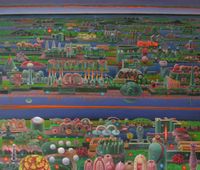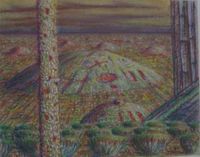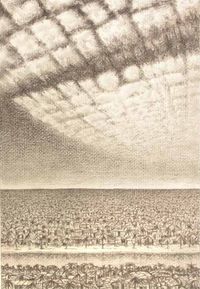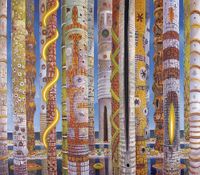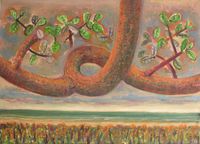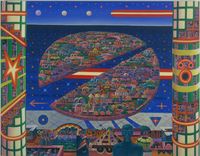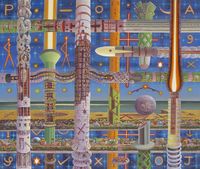In Jyothi Basu's detailed drawings and paintings, disparate spheres of the urban and rural, ancient and futuristic, and organic and geometric converge to create fantastic landscapes.
Read MoreJyothi Basu studied at the College of Fine Arts Kerala in the 1980s, during which time he was affiliated with the Indian Radical Painters and Sculptors Association. The short-lived movement, led by K.P. Krishnakumar and based in Basu's home-state of Kerala, opposed the increasing commodification of art and called for social awareness and rejection of academic-style painting in India.
Many of Jyothi Basu's works from the 1980s are portraits of his friends and colleagues, as well as self-portraits. Charcoal drawing Chittrabanu (1983) shows a seated figure absorbed in reading; Yohannan (1986) emphasises the silhouette of another seated figure by varying the weight of the outline.
Upon completing his studies at the The Maharaja Sayajirao University Baroda in Gujarat in 1991, Jyothi Basu decided against pursuing a career in art and worked instead as a set designer for television channels. Returning to painting in 1998, Jyothi Basu began to explore the themes of death and resurrection. The resulting paintings, such as the iconic 'Resurrection' series of the late 1990s, depict fantastic landscapes rendered in vivid colours.
A sense of the monumental looms large in works such as Resurrection series (Rays 2) (1999): a single curving tree-trunk hovers over an ocean, appearing massive and evoking a gigantic creature. In the background, clouds modelled as masses of grey recall alien spaceships, while the rays of sunlight that pierce through them accentuate the sublime atmosphere.
Jyothi Basu has continued to create paintings that exist in an ambiguous time. Tall, column-like structures occupy the canvas in Farewell Party (2004) or Order Breaks from Within (2005). Though devoid of human figures, activities such as flames bursting from the necks of towers and objects hovering in the air suggest the presence of a civilisation. Basu employs a range of patterns and textures for his structures: irregular and regular, geometric and figurative, as well as symbols rendered in neon-like lights, offering a sense of both the archaic and the futuristic.
V. N. Jyothi Basu—Portraits and Landscapes on Paper, Galerie Mirchandani + Steinruecke, Mumbai (2018); Landscape towards a Supreme Fiction, Thomas Erben Gallery, New York (2006); Visionary Antiquities, Nature Morte, New Delhi, and Galerie Mirchandani + Steinruecke, Mumbai (2006).
Nine Painters from Kerala, Galerie Mirchandanie + Steinruecke, Mumbai (2018); Kochi-Muziris Biennale (2012); India Inclusive: Contemporary Art from India, World Economic Forum, Davos, Switzerland (2011); Santhal Family, Museum of Contemporary Art Antwerp (2008).
Sherry Paik | Ocula | 2021
